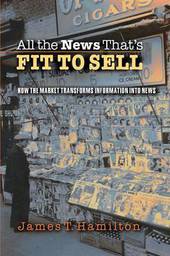
|
All the News That's Fit to Sell: How the Market Transforms Information into News
Paperback / softback
Main Details
| Title |
All the News That's Fit to Sell: How the Market Transforms Information into News
|
| Authors and Contributors |
By (author) James T. Hamilton
|
| Physical Properties |
| Format:Paperback / softback | | Pages:352 | | Dimensions(mm): Height 235,Width 152 |
|
| Category/Genre | Economics |
|---|
| ISBN/Barcode |
9780691123677
|
| Classifications | Dewey:302.23 |
|---|
| Audience | | Professional & Vocational | | Tertiary Education (US: College) | |
|---|
| Illustrations |
8 line illus. 70 tables.
|
|
Publishing Details |
| Publisher |
Princeton University Press
|
| Imprint |
Princeton University Press
|
| Publication Date |
2 April 2006 |
| Publication Country |
United States
|
Description
Whether a story appears in print, on television, or on the Internet depends on who is interested, its value to advertisers, the costs of assembling the details, and competitors' products. This book develops an economic theory of news, analyzes evidence across a range of media markets on how incentives affect news content, and offers conclusions.
Author Biography
James T. Hamilton is Charles S. Sydnor Professor of Public Policy, Economics, and Political Science at Duke University. He has written or coauthored six books, including "Regulation through Revelation" and "Channeling Violence" (Princeton), which won the Shorenstein Center's Goldsmith Book Prize. He is also a recipient of the David N. Kershaw award for distinguished public policy research.
ReviewsWinner of the 2004 Frank Luther Mott Kappa Tau Alpha Journalism and Mass Communication Research Award "More than ever before, Mr. Hamilton argues, hard news is not what fattens the newsstands or fills the airwaves. Instead we have celebrity profiles, product hype or what we used to call human-interest stories... Mr. Hamilton slices and dices cyberhit sums to show that the Internet marketplace is a lot like the older one... The title tarts up what is essentially an academic analysis of changes in the media marketplace. But there is nothing wrong with that: Selling is, after all, what purveyors of information do, and Mr. Hamilton has something to purvey."--Tim W. Ferguson, The Wall Street Journal "As Hamilton shows, news is now presented to specific audiences, depending on marketing decisions, with a resultant shift from political news to softer topics such as entertainment. He recommends ways to counteract this situation and increase the amount of hard news available to the consumer."--Library Journal "Using a variety of surveys and statistical charts of who watches what and how the news menu has been altered, Hamilton doesn't just assert the change; he proves it... [He] does not demonize news/marketing executives. He demonstrates that younger audiences prefer sports to international news, health and lifestyle to government news, more conflict and less exposition. The bottom line is that news brims with conflict and the adversarial pose that substitutes for hard information."--Ken Auletta, Los Angeles Times Book Review "Hamilton takes the analysis of news stories back to basics, reminding us that information is transformed into news--that most ephemeral and fragile of commodities--when there is an identifiable market for it and when it seems likely to yield a profit. In so doing, he opens up abundant possibilities for parallel studies and for a radical re-interpretation of the history of journalism."--Dilwyn Porter, Business History
|